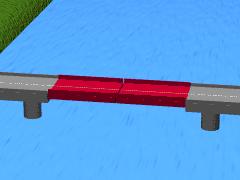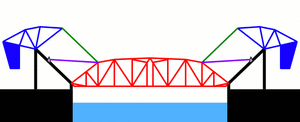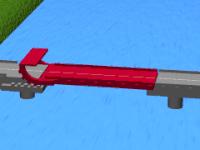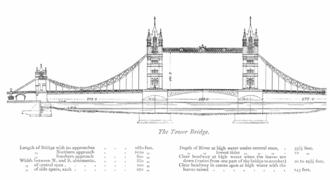This animation shows the movement of a double-leaf bascule.  | |
| Ancestor | Drawbridge, Plate girder bridge, cantilever bridge |
|---|---|
| Related | Lift bridge, swing bridge |
| Descendant | None |
| Carries | Pedestrian, bicycle, automobile, truck, light rail, heavy rail |
| Span range | Short |
| Material | Steel |
| Movable | Yes |
| Design effort | Medium |
| Falsework required | Site and prefabrication specific |
A bascule bridge (also referred to as a drawbridge or a lifting bridge) is a moveable bridge with a counterweight that continuously balances a span, or leaf, throughout its upward swing to provide clearance for boat traffic. It may be single- or double-leafed.
The name comes from the French term for balance scale, which employs the same principle. Bascule bridges are the most common type of movable span because they open quickly and require relatively little energy to operate, while providing the possibility for unlimited vertical clearance for marine traffic.
History
Bascule bridges have been in use since ancient times, but until the adoption of steam power in the 1850s, very long, heavy spans could not be moved quickly enough for practical application.
Types

There are three types of bascule bridge,[1] and the counterweights to the span may be located above or below the bridge deck.
The fixed-Trunnion (sometimes a "Chicago" bascule) rotates around a large axle that raises the span(s). The Chicago bascule name derives from the location where it is widely used, and is a refinement by Joseph Strauss of the fixed-trunnion.[2]

The rolling lift trunnion (sometimes a "Scherzer" rolling lift), raises the span by rolling on a track resembling a rocking-chair base. The "Scherzer" rolling lift is a refinement patented in 1893 by American engineer William Donald Scherzer.[3]
The rarer Rall type combines rolling lift with longitudinal motion on trunnions when opening.[4] It was patented (1901) by Theodor Rall.[2][4][5] One of the few surviving examples is the Broadway Bridge (1913), in Portland, Oregon.[4][6]
Examples
Tower Bridge in London, opened, viewed from the northwest
White Cart Bridge, Renfrew, Scotland
The Birkenhead Bridge in Port Adelaide, Australia, fully opened
Cherry Street Bridge at Keating Channel in Toronto, Canada
Mystic River Bascule Bridge, Mystic, Connecticut
Palace Bridge in Saint Petersburg
Pamban Bridge over the Palk Strait in Rameswaram, India
Rolling lift Pegasus Bridge over the Caen Canal, Normandy, France
Bascule bridge in Montceau-les-Mines, France
Salmon Bay Bridge, a single-leaf through truss with overhead counterweight, Seattle, Washington, US
Kuala Terengganu Drawbridge in Terengganu, Malaysia
Yeongdodaegyo in Busan, South Korea
Via Rail Dayliner crossing the Johnson Street Bridge after completing a Victoria-Courtenay round trip, 13 May 2008
The Strauss design Johnson Street Bridge across Victoria Harbour, British Columbia, Canada, built in 1924
The new Johnson Street Bridge in Victoria, British Columbia, Canada
See also
- Double-beam drawbridge
- Drawbridge
- List of bascule bridges
- Moveable bridges for a list of other movable bridge types
- Johnson Street Bridge
- Joseph Strauss (engineer)
- nl::Straussbrug
References
- ^ Koglin, Terry L. (2003). "4. Bascule Bridges". Movable bridge engineering. John Wiley and Sons. ISBN 978-0-471-41960-0. Retrieved May 25, 2009.
- ^ a b "Landmark Designation Report: Historic Chicago Bridges" (PDF). Commission on Chicago Landmarks. September 2007 [September 2006]. pp. 12, 15 (pdf pages 14, 17). Retrieved April 21, 2013.
- ^ US grant 511713, Scherzer, William, "Lift-Bridge", issued 26 December 1893
- ^ a b c Wood Wortman, Sharon; Wortman, Ed (2006). The Portland Bridge Book (3rd Edition). Urban Adventure Press. pp. 32, 35. ISBN 0-9787365-1-6.
- ^ "Patent number 669348: T. Rall movable bridge". United States Patent and Trademark Office (referenced online by Google Patents). 1901. Retrieved April 21, 2013.
- ^ Historic American Engineering Record. "Broadway Bridge, Spanning Willamette River at Broadway Street [sic], Portland, Multnomah County, OR". Library of Congress. Retrieved April 21, 2013.
.jpg)






.jpg)


.jpg)












.jpg)